What are calcium nodules?
In swimming pools and spas, they are small mounds, bumps, deposits, or “slag” piles of calcium carbonate which are formed from material that has been released from the plaster. The small calcium nodules are rough to the touch, hard, and generally gritty. Nodules may form singularly (far apart or sporadically), or many and close together along a crack in the plaster surface.
Here are some pictures of calcium nodules: The first picture is of black colored plaster with many white calcium nodules forming along cracks in the plaster surface.
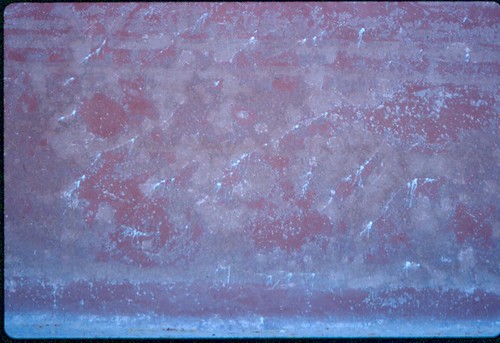
The second picture is of a single large calciuim nodule on old white plaster with copper (turquoise) staining present.

In the cement/concrete industry, this phenomenon would be called a form of “efflorescence” (but in keeping with the spirit of common pool industry practice, we call them “calcium nodules” instead…)
The most common type of nodule is the “delamination” nodule. These nodules grow because of a void (usually a bond separation) between plaster and its substrate. Here is the sequence:

Under normal conditions, the plaster (white) is exposed to the water (blue), is bonded to the gunite substrate (speckled), which in turn rests on dirt (tan). (Picture not to scale…)
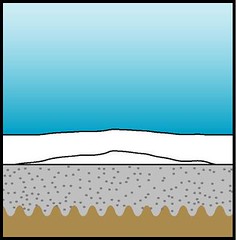
Sometimes, an air cavity (a bond failure) can form between the gunite and the plaster, or between multiple layers of plaster. This is referred to as “delamination” and the cavity is referred to as a “void.” As long as the void is not connected to the surface of the plaster, the fact that the void even exists may not be known. Unless the plaster completely breaks free from the surrounding plaster, creating what is referred to as a “pop–off,” or unless the delamination is extensive, this is not considered by the plaster industry to be a defect.

In some cases, however, the void is connected to the surface by a small pinhole or hairline crack. Pinholes and cracks are often created from structural flexing of the delaminated plaster.
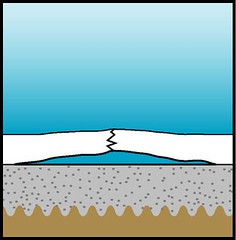
Gradually, water from the pool penetrates the void via the hole or crack, and creates a localized chemistry environment completely separate from the water balance in the pool. As calcium hydroxide bleeds into the void water, it creates a calcium–rich, high pH solution like a little “calcium/pH factory” beneath the plaster surface. The pinhole or crack is not of sufficient size to create a rinsing effect like that which occurs at a new plaster surface.

Calcium–rich void water and pool water containing bicarbonate alkalinity, in contact with each other at the plaster surface, react with each other, which results in the production of an insoluble calcium carbonate by-product.
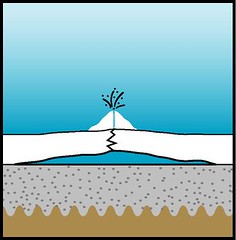
If the conditions are right, this insoluble calcium carbonate can build up a “slag pile” around the exit point, thus forming a nodule.
Attempts to remove a nodule through scraping, sanding, or a direct acid treatment, can be successful – but the node may reform on the same site once or twice, until all of the source hydroxide is used up. Then it shouldn’t come back.
Acid washing nodules off usually isn’t the best response, since the calcium carbonate it is made of is the same stuff much of the plaster is made of. So to dissolve the one, you also dissolve some of the other.
Plugging the hole, by drilling and epoxying, has been successfully used to stop nodule formation, since water can then no longer travel in either direction. BUT REMEMBER, DRAINING THE POOL MAY CAUSE MORE DELAMINATIONS TO OCCUR, AND IT IS LIKELY THAT MORE NODULES WILL FORM AGAIN AFTER THE POOL IS FILLED WITH WATER. So this repair should be performed under water.
It is important to keep in mind that nodules are a symptom, rather than the disease itself. The disease is bond failure, cracking or some other imperfection that allows water “to boldly go where no water has gone before” (sorry, Captain Kirk).
Nodules that form on horizontal surfaces like pool floors end up round shaped:
While those that form on walls drip downward, reminiscent of some stalactites:
Although the calcium carbonate is white, and thus pure calcium nodules are white, when the crystalline matrix incorporates or absorbs dirt, metals, or other contaminants the nodule takes on a color:
Another type of nodule is associated with crazing (small cracks in the plaster) rather than with delamination. Craze cracking can form from high heat, excessive wind, low humidity, or from shrinkage due to excess water or calcium chloride in the mix. Plaster is capable, to a certain degree, of “backfilling” craze cracks with calcium hydroxide, which later carbonates. (Technical term: autogenously healing)
Some of the hydroxide releases into the pool water, and is converted to calcium carbonate “plaster dust.” However, if conditions are right, especially if an extensive network of shrinkage micro fissures is present, nodules can form at these initiation sites
If the surface is sanded or acid washed, the existing nodules may be removed. However, more of the craze network is exposed, and many more nodules may then be formed.
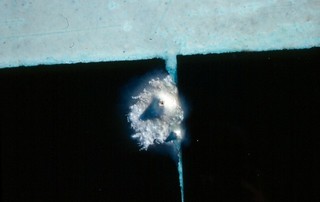
Nodules can even grow on tile grout! This is actually two nodes – a large one to the upper left and a smaller one to the lower right. Notice the “volcano hole” where the continuing process happens!
But the mechanism is the same. In this instance, the source of the calcium- and hydroxide-rich solution is a delamination in the grout/plaster/gunite interfaces:
Nodules can also form on fiberglass surfaces! However, research has shown that in these instances, pinholes existed in the fiberglass, and the source of the node material (calcium) was the plaster/gunite beneath the fiberglass coating:
For decades, it was understood among plasterers that calcium nodules primarily formed due to bonding failure (delamination) of a new coat of plaster, and occasionally from severe craze cracking, and that they were responsible for this plaster defect. Plasterers learned that bonding failure rarely occurs on fresh gunite substrates (new pools); however, bonding new plaster (replaster) to old plaster surfaces can occasionally be difficult to achieve. This is why most calcium nodules occur in replaster jobs.
Unfortunately today, some in our industry (primarily plasterers) will claim that faulty water chemistry maintenance is the direct cause of nodules. That is absolutely incorrect. High water hardness and high pH will cause a uniform layer of calcium scale throughout a pool surface, not in isolated and individual spots (bumps). Service techs and pool owners should not accept the blame that their chemical treatment caused this plaster defect. Aggressive water would actually prevent nodules from forming, and properly balanced water will not prevent nodules from forming, but actually facilitates the visible growth that exposes the underlying problem.
Other good pictures and information regarding calcium nodules can be found at this post: Calcium Deposits on pool wall
In swimming pools and spas, they are small mounds, bumps, deposits, or “slag” piles of calcium carbonate which are formed from material that has been released from the plaster. The small calcium nodules are rough to the touch, hard, and generally gritty. Nodules may form singularly (far apart or sporadically), or many and close together along a crack in the plaster surface.
Here are some pictures of calcium nodules: The first picture is of black colored plaster with many white calcium nodules forming along cracks in the plaster surface.

The second picture is of a single large calciuim nodule on old white plaster with copper (turquoise) staining present.

In the cement/concrete industry, this phenomenon would be called a form of “efflorescence” (but in keeping with the spirit of common pool industry practice, we call them “calcium nodules” instead…)
The most common type of nodule is the “delamination” nodule. These nodules grow because of a void (usually a bond separation) between plaster and its substrate. Here is the sequence:

Under normal conditions, the plaster (white) is exposed to the water (blue), is bonded to the gunite substrate (speckled), which in turn rests on dirt (tan). (Picture not to scale…)

Sometimes, an air cavity (a bond failure) can form between the gunite and the plaster, or between multiple layers of plaster. This is referred to as “delamination” and the cavity is referred to as a “void.” As long as the void is not connected to the surface of the plaster, the fact that the void even exists may not be known. Unless the plaster completely breaks free from the surrounding plaster, creating what is referred to as a “pop–off,” or unless the delamination is extensive, this is not considered by the plaster industry to be a defect.

In some cases, however, the void is connected to the surface by a small pinhole or hairline crack. Pinholes and cracks are often created from structural flexing of the delaminated plaster.

Gradually, water from the pool penetrates the void via the hole or crack, and creates a localized chemistry environment completely separate from the water balance in the pool. As calcium hydroxide bleeds into the void water, it creates a calcium–rich, high pH solution like a little “calcium/pH factory” beneath the plaster surface. The pinhole or crack is not of sufficient size to create a rinsing effect like that which occurs at a new plaster surface.

Calcium–rich void water and pool water containing bicarbonate alkalinity, in contact with each other at the plaster surface, react with each other, which results in the production of an insoluble calcium carbonate by-product.

If the conditions are right, this insoluble calcium carbonate can build up a “slag pile” around the exit point, thus forming a nodule.
Attempts to remove a nodule through scraping, sanding, or a direct acid treatment, can be successful – but the node may reform on the same site once or twice, until all of the source hydroxide is used up. Then it shouldn’t come back.
Acid washing nodules off usually isn’t the best response, since the calcium carbonate it is made of is the same stuff much of the plaster is made of. So to dissolve the one, you also dissolve some of the other.
Plugging the hole, by drilling and epoxying, has been successfully used to stop nodule formation, since water can then no longer travel in either direction. BUT REMEMBER, DRAINING THE POOL MAY CAUSE MORE DELAMINATIONS TO OCCUR, AND IT IS LIKELY THAT MORE NODULES WILL FORM AGAIN AFTER THE POOL IS FILLED WITH WATER. So this repair should be performed under water.
It is important to keep in mind that nodules are a symptom, rather than the disease itself. The disease is bond failure, cracking or some other imperfection that allows water “to boldly go where no water has gone before” (sorry, Captain Kirk).
Nodules that form on horizontal surfaces like pool floors end up round shaped:
While those that form on walls drip downward, reminiscent of some stalactites:
Although the calcium carbonate is white, and thus pure calcium nodules are white, when the crystalline matrix incorporates or absorbs dirt, metals, or other contaminants the nodule takes on a color:
Another type of nodule is associated with crazing (small cracks in the plaster) rather than with delamination. Craze cracking can form from high heat, excessive wind, low humidity, or from shrinkage due to excess water or calcium chloride in the mix. Plaster is capable, to a certain degree, of “backfilling” craze cracks with calcium hydroxide, which later carbonates. (Technical term: autogenously healing)
Some of the hydroxide releases into the pool water, and is converted to calcium carbonate “plaster dust.” However, if conditions are right, especially if an extensive network of shrinkage micro fissures is present, nodules can form at these initiation sites
If the surface is sanded or acid washed, the existing nodules may be removed. However, more of the craze network is exposed, and many more nodules may then be formed.

Nodules can even grow on tile grout! This is actually two nodes – a large one to the upper left and a smaller one to the lower right. Notice the “volcano hole” where the continuing process happens!
But the mechanism is the same. In this instance, the source of the calcium- and hydroxide-rich solution is a delamination in the grout/plaster/gunite interfaces:
Nodules can also form on fiberglass surfaces! However, research has shown that in these instances, pinholes existed in the fiberglass, and the source of the node material (calcium) was the plaster/gunite beneath the fiberglass coating:
For decades, it was understood among plasterers that calcium nodules primarily formed due to bonding failure (delamination) of a new coat of plaster, and occasionally from severe craze cracking, and that they were responsible for this plaster defect. Plasterers learned that bonding failure rarely occurs on fresh gunite substrates (new pools); however, bonding new plaster (replaster) to old plaster surfaces can occasionally be difficult to achieve. This is why most calcium nodules occur in replaster jobs.
Unfortunately today, some in our industry (primarily plasterers) will claim that faulty water chemistry maintenance is the direct cause of nodules. That is absolutely incorrect. High water hardness and high pH will cause a uniform layer of calcium scale throughout a pool surface, not in isolated and individual spots (bumps). Service techs and pool owners should not accept the blame that their chemical treatment caused this plaster defect. Aggressive water would actually prevent nodules from forming, and properly balanced water will not prevent nodules from forming, but actually facilitates the visible growth that exposes the underlying problem.
Other good pictures and information regarding calcium nodules can be found at this post: Calcium Deposits on pool wall
Last edited:



